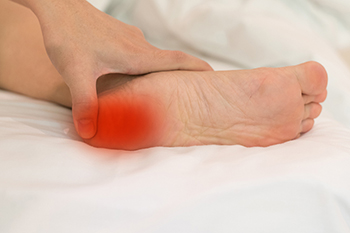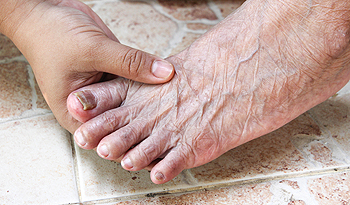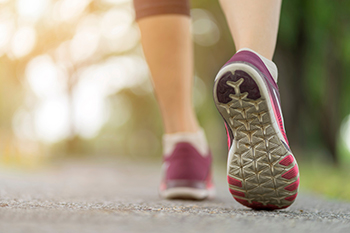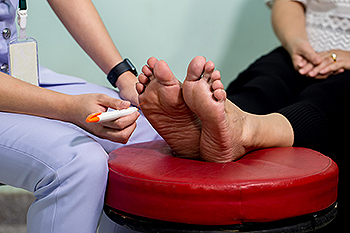Items filtered by date: June 2022
Common Types of Pain Under the Heel

Experiencing heel pain is quite common, especially as one ages or if one is active in sports. The number one pain under the heel is plantar fasciitis, an inflammation of the band of tissue that runs from the heel to the front of the foot. It is usually caused by overuse, and is common among runners. Similar to plantar fasciitis, but not the same, is bruised heel pain. Also known as heel pad contusion, this pain is specific to the heel bone (calcaneus) rather than along the sole of the foot. It might be the result of landing too hard on a hard surface or from a great height. A heel spur is a bony growth on the heel bone that can be overlooked, or thought to be plantar fasciitis as the symptoms are identical. A chiropodist can determine the difference by taking an X-ray. Tarsal tunnel syndrome is caused by pressure on the posterior tibial nerve as it passes through the inner ankle. It causes a burning pain in the heel that then moves to the arch of the foot. A calcaneal stress fracture, an overuse injury, is a hairline crack in the main heel bone. For help with any of these forms of heel pain, please consult a chiropodist.
Heel pain is a common problem that can be caused by a variety of injuries, medical conditions, and other factors. If you suffer from heel pain, please consult with one of the chiropodists from Complete Family Footcare & Therapy. Our clinicians can help you maintain the health of your lower limbs and your mobility.
When it comes to heel pain, the exact location and type of pain are important to note. Some of the conditions that may cause heel pain include:
Plantar fasciitis - An inflammation of the ligament that runs along the bottom of the foot; it causes a stabbing pain under the heel that is at its worst when taking your first few steps after a long rest and while standing on your tiptoes or climbing stairs
Achilles tendonitis - An inflammation of the tendon in the back of the calf; it causes pain in the back of the heel that is at its worst after resting, as well as ankle and calf stiffness, swelling, and tenderness
Bone spurs - Bony lumps on the back of the heel bones that cause sharp pain upon first standing up; the pain becomes dull and achy over time
Heel fractures - A break or crack in the heel bone that causes pain, swelling, and difficulty walking
Retrocalcaneal bursitis - Swelling of the small, fluid-filled sac at the back of the heel bone; it causes pain, swelling, redness, and warmth in the back of the heel
Tarsal tunnel syndrome - Compression of the posterior tibial nerve which causes a pins and needles sensation in the heel, foot, and calf
Your chiropodist will be able to diagnose the underlying cause of your pain and prescribe the right treatments for you. If you have any questions, please feel free to contact our offices located in . We offer the newest diagnostic and treatment technologies for all your foot care needs.
Common Foot Conditions Seniors May Develop

Approximately one quarter of the bones in the body are located in the feet. The feet are responsible for supporting the body’s weight by acting as shock absorbers and maintaining balance. One third of people who are older than 65 have foot problems, which may be a result of a diminished ability to exercise, having drier skin, and being overweight. Additionally, the fat pads in the heel may become smaller leading to flattened arches. Some of the common foot problems experienced by many seniors include bunions, hammertoes, ingrown toenails, and gout. Bunions and hammertoes may develop from wearing shoes that do not fit correctly. Gout is a form of arthritis, and can come from genetic factors or from eating foods that have high levels of purines. This condition can cause debilitating pain, and it is advised to avoid eating these types of foods. Elderly people can practice good foot care by performing proper foot hygiene, applying lotion to the skin, and wearing shoes and socks that fit correctly. For additional information about how to care for elderly feet, please schedule an appointment with a chiropodist.
Foot problems can become increasingly common as we age, making everyday foot care especially important. To learn more about maintaining proper foot health, please consult with one of the chiropodists from Complete Family Footcare & Therapy. Our clinicians will assess your condition and provide you with quality foot and ankle treatment.
Common Foot Problems
Certain foot problems may be more likely to affect older adults.
Some examples of foot conditions that can be common in older adults include:
Dry, cracked skin
Calluses and corns
Blisters
Ingrown toenails
Deformities such as bunions or hammertoes
Fungal infections
Plantar warts
Systemic conditions, such as diabetes or arthritis, are also more likely to affect older people and manifest symptoms in the feet and ankles.
Daily Foot Care Tips
Having a daily foot care routine can help detect problems early on and prevent future issues.
Things that you can do at home to care for your feet include:
Washing the feet daily with warm water, drying them thoroughly, and then applying a moisturizer
Trimming the toenails straight across and not too short to prevent ingrown toenails
Performing daily foot exercises to improve foot strength and mobility
Wearing shoes when walking to avoid injury
Inspecting the feet daily for any cuts, scrapes, sores, or other abnormalities and seeking prompt treatment if any problems are discovered
If you have any questions, please feel free to contact our offices located in . We offer the newest diagnostic and treatment technologies for all your foot care needs.
Dealing With Drop Foot

If your toe drags on the ground as you take a step, it may indicate a drop foot. To compensate for the inability to lift or flex the foot, you may begin to raise your legs higher with each step. This is termed steppage gait. Causes of drop foot include weakened muscles or damage to the peroneal nerve which allows you to flex your foot. Non-surgical treatment may consist of a course of electronic stimulation or wearing a brace called an ankle-foot-orthosis, (AFO). The bottom part of this device supports the sole of the foot, while the top part attaches to the lower leg. In combination, the brace helps your foot and ankle operate more normally. In severe cases of drop foot, a surgical treatment called tendon transfer may be required. If a drop foot increasingly affects your daily activities, it is wise to consult a chiropodist for an examination, a diagnosis, and the right treatment options for you.
The biomechanics of your feet play an important role in your foot health. To learn more, please consult with one of the chiropodists from Complete Family Footcare & Therapy. Our clinicians can help you maintain the health of your lower limbs and your mobility.
Foot biomechanics refers to the study of the structure, function, and motion of the feet. The feet and ankles are a complex system consisting of many bones, joints, ligaments, muscles, and tendons that work together to move your feet. Understanding the unique biomechanics of your own feet can help you and your chiropodist make informed decisions about your foot health care. This includes decisions about the best preventive measures to avoid foot pain, the best treatment options for various foot problems, and finding the best shoes for your feet.
If you have any questions, please feel free to contact our offices located in . We offer the newest diagnostic and treatment technologies for all your foot care needs.
Plantar Warts Can Be Treated!
A Mirror May Be Used for Proper Foot Inspection

Maintaining proper foot care in diabetic patients is important for their overall health. Elevated blood sugar levels can cause many foot conditions to develop that can include neuropathy, and the inability to heal from sores and wounds on the feet. It is crucial for people who have diabetes to check their feet daily as this may help to prevent foot ulcers from developing. A foot infection may lead to discolored skin, blisters, and chronic pain. It is common for diabetic patients to have toenail fungus, calluses, and corns. This can be a result of diabetic neuropathy, which may cause uneven weight distribution while walking. Proper foot care can consist of inspecting the feet daily and this is often done by using a mirror. Washing and drying the feet thoroughly can make the feet feel good in addition to wearing shoes and socks that fit correctly. It is strongly suggested to seek the expertise of a chiropodist for all diabetic patients, and routine visits are beneficial in managing diabetes.
Diabetes can cause serious problems in the lower limbs if proper preventive measures are not taken and diabetic wound care is not performed. If you would like to learn more about caring for diabetic feet, please consult with one of the chiropodists from Complete Family Footcare & Therapy. Our clinicians can help you maintain the health of your lower limbs and your mobility.
Diabetes can lead to a host of foot and ankle complications, including:
Poor circulation
Peripheral neuropathy
Diabetic foot wounds and ulcers
Infection
Corns and calluses
Dry, cracked skin
Nail disorders
Hammertoes
Bunions
Charcot foot
If you have diabetes, you must be vigilant of any changes in your foot health. This is best done through daily foot inspections. Using a mirror to help you if necessary, look for any:
Cuts, scrapes, sores, or wounds
Bruising or discoloration
Swelling
Rash
Foul odor
Nail changes
Hair loss
Warmth and inflammation
Deformities
Lower limb pain
Strange sensations (numbness, tingling, burning, pins, and needles)
If you detect anything unusual, seek the care of a chiropodist as soon as possible. If you have any questions, please feel free to contact our offices located in . We offer the newest diagnostic and treatment technologies for all your foot care needs.

